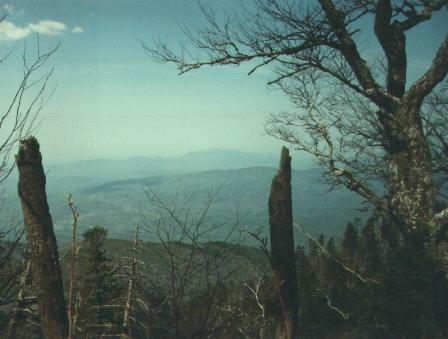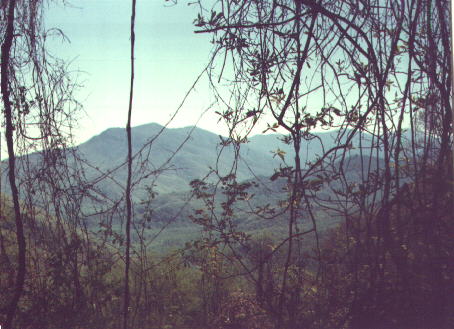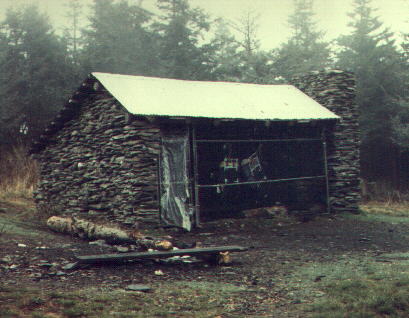
View from Cliff Tops

Mount LeConte is the terminating pinnacle of a five-mile spur off the Great Eastern Divide, the ridge separating Tennessee from North Carolina. Formerly, the mile-high wall of the Eastern Divide literally separated the 'civilized' east from Indian Territory to the west. LeConte is distinctive in its three prominent peaks, all above 6,000 feet, running almost due east-west. It overshadows the small tourist town of Gatlinburg, nestled six miles northwest of and one mile beneath its crown.

View from Cliff Tops
Leconte's three peaks are Cliff Tops, High Top and Myrtle Point. Cliff Tops is the westward-facing peak, only a quarter mile walk from the camp. This is where the sunset is viewed. As can be gathered from the name, the rocks here cap a cliff several hundred feet high. Can you find the USGS survey benchmark here? High Top is the center and tallest point on Mount LeConte at 6593 feet above sea level (only 50 lower than Clingman's Dome). It is wooded and offers no views to speak of. There is an odd pile of rocks here. There is a tradition to throw a rock onto the pile with each visit. Eventually, it is hoped, LeConte will be taller than Clingman's Dome! Well, in any case, it makes fun conversation. And last, but not least, is Myrtle Point, an eastward facing heath bald and rock outcropping. It is 0.8 miles from the cabins, a fun walk. The finest vantage points from which one may view the entire Leconte range are: Gatlinburg, Sevierville, even moreso on the Chimney Tops from the south and Brushy Mountain, a quarter mile jaunt off the Trillium Gap trail, is, in my opinion, the most impressive way to view the mountain.

Back side of the Mount Leconte Lodge.
A rustic lodge with accommodations is available at the top of Mount LeConte. Do not expect to get reservations easily, though. The first week in October is normally the time to reserve for the following season. Even then, you are lucky to find a Friday or Saturday night to your liking. ATTENTION: you cannot just show up and get either room or board even if there are openings. There are both private cabins and two lodges available for groups. Either offers double width bunks covered with several thick woolen blankets. These are usually necessary all year round as temperatures at night seldom exceed 50. Heating is accomplished by portable kerosene heaters, which are a bit smelly. Bureaucrats and insurance companies banned the wonderful wood heaters and fireplaces originally installed. Lighting is provided by kerosene lamp, quite adequate and cozy. Mice are very common and necessitate storing all packed food in barrels provided at the 'front desk.' It is not uncommon to wake up to the pitter patter of little feet in backpacks, even if there is no food in them. Bears also frequent the site mooching for morsels. Although less common than in years past, they still get inside the buildings on occasion. Rest rooms are outside, and actually have plumbing! Pit toilets are also available for those without reservations (or those who leave their key in their cabin). A collection of games is stacked in the main meeting room, along with books, pictures, guitars and other gizmos. No showers, phones or electricity will be found here (a benefit, by my standards!).
Also available on top of Mount LeConte is a back-country shelter. It is basically a lean-to with a chicken wire fence over the entrance to discourage bears. Reservations are required and it is not easy to obtain them in crowded seasons - late spring and fall. Crude (and not too comfortable) bedding is found inside, although I personally prefer sleeping on the ground. No facilities are offered except a fire ring. Drinking water and pit toilets may be found the lodge, less than a quarter of a mile away.

The back-country shelter at Mount LeConte.
Two meals are provided with lodge reservations: supper at 6 p.m. and breakfast at 8 a.m. The menu doesn't change, to my knowledge, and meals are served only when the dinner bell rings. Supper consists of soup and corn bread followed by a hearty beef and gravy stroganoff-ish dish with reconstituted potatoes, canned green beans, baked apples and finally, a cookie or two for desert. Hot chocolate and coffee are unlimited as long as they hold out. Wine is served if you make the request when you reserve the room. Breakfast will be pancakes and grits, biscuits, ham, scrambled eggs, instant orange drink, coffee, hot chocolate, along with honey, syrup, apple butter and the like. Meals are not fancy but substantial and 'just what the doctor ordered' after a long hike up a tall mountain.
Those wishing to experience it first hand have quite a few options for ascending this Queen of the Smokies. The shortest and probably easiest, is the Alum cave trail. This is five and a half miles with a vertical climb of around 2600 feet. Strangely, most claim the easiest is via Newfound Gap, an eight mile trip, but only a vertical climb of 1200 feet. However, I strongly take issue with these claims. The eight mile jaunt is fairly populated and nothing but up and down the entire way. By my calculations off the quadrangle map, it climbs around 2500 feet and drops about 1300 feet. The Rainbow Falls trail is around 6.7 miles, climbing almost 4000 feet. The Bullhead trail starts and ends at the same spot as the Rainbow Falls trail, hence also gains about 4000 feet, but in about seven miles. It is slightly less scenic, but also less traveled that the Rainbow Falls route. The Trillium Gap, or Grotto Falls trail is similar in length and only slightly less difficult than the Rainbow Falls trail, gaining 3500 feet. Its trail head is not far beyond the Rainbow Falls and Bullhead parking area. There is a little used, not particularly scenic two mile path connecting the two parking areas for those who wish to travel up one and down the other. Since this path adds two miles to the tiring trip, you may consider going up Rainbow Falls and down Grotto Falls. A benefit of this is that there is a sign at the Grotto Falls trail head, but not at the Rainbow Falls end. Yet another way to reach Mount LeConte by Trillium Gap is from Porter's Creek Campground, a 9.5 mile very scenic outing. Perhaps a couple of other routes could be contrived by joining up with the Appalachian trail on the Boulevard at Icewater Springs shelter, three miles north of Newfound Gap. (Newfound Gap is where U.S. highway 441 crosses the Eastern Continental Divide, between Gatlinburg and Cherokee, N.C.)
We have traveled all these trails, most of them numerous times. In our opinion, the Alum Cave Bluffs trail offers the most "bang for the buck." It takes you through old hardwood forest, creeks, spectacular overlooks, over, under, through(!) and on rock cliffs, rhododendron 'tunnels', blueberries, really the best buffet tour of the Great Smoky Mountains. There are a couple of drawbacks. First, you will not be alone. That may not be bad to some, but if you are looking for more walking "away from them all," I would recommend Bullhead. A second drawback of Alum Cave is that you are fairly well destined to take the same path down as up, though this may not bother you. Or you may either arrange to get a ride down from Newfound Gap or swap cars with a friend taking a different route up. In wet weather, Rainbow Falls and Grotto Falls are very nice. Unfortunately, Grotto Falls is often packed with day hikers, though in wet weather, it also is solitary.
The Alum Cave trail is also handy for those making a day hike to LeConte. At eleven miles round trip, the spunky hiker can make it up and back in an afternoon. Albert did this countless times while living in Knoxville. Sometimes leaving after classes, setting out on the trail around supper time, running most of the way up, catching a quick sunset and dashing back to the car during (or more likely after) twilight! Day hikes made from Rainbow Falls or Trillium Gap are good, too, but can be exhausting - start early. It is hard to enjoy the walk when you're bushed and thinking only of a hot meal, hot shower and taking off those sweaty hiking shoes.
Whether you are on a day hike or overnight, bring plenty of water with you. A half-gallon per person is not too much. Though water is abundant on the trail, it can bring various bacterial bummers to ruin your journey. A sack lunch is good, though luncheon meats in a hot pack may also breed intestinal tribulation. Trail mix type foods are recommended, as they supply salt and sugar, your next biggest needs (after water) on the trail.
Let's talk about the weather. It has been said (at least now it has) that there is a devious spirit haunting the peaks of Mount LeConte. This mischief-making gremlin seems to invoke fog and showers at its capricious will on the fairest of days. When at lower altitudes the weather is hot, hazy and humid (look for cumulus clouds), expect about a 75% chance of scattered showers and fog on Mount LeConte. The scientific excuse for this goblin is as follows. The warm, moist valley air rushes up the 5000 foot tall slope, driven by west winds. The increase of altitude forces a drop in pressure, reducing the density and therefore cooling in the process. As the temperature drops below the dew point, the water begins to condense, forming water droplets, which coalesce, drenching the innocent and bewildered hiker with pinpoint accuracy. This will happen day or night, summer, winter, springtime and fall. Many times, the cloud will hover just around High Top, bobbing above and then below the treetops. This makes sunsets and sunrises an unpredictable sight. The best attitude to have is this: regardless of the weather, you are in a wonderful place away from bosses, phone calls, bills and IRS agents: enjoy the flora, rocks, fresh air and clean water (available at the camp). If you are staying the night, you can look forward to a warm, dry bed and plenty of hot food. If you see the sunset, great! If not, come back and try again! It really does happen once in a while.

Friendly neighborhood llama.
Just a couple of criticisms: the fabulous wood heaters have been replaced with stinky kerosene - YUCK! And be prepared to pack your trail goodies very tightly overnight, mice are everywhere after about 11 pm.
If you are fortunate enough to come at a time when the skies are clear, take advantage of it! Spend a few minutes (or hours) during the middle of the night looking at the stars and the lights of the surrounding cities. And for goodness sakes, don't miss the sunrise on Myrtle Point. Get there at least a half hour before the posted sunrise time. First morning light is mighty gorgeous and often you will be the only one there - you feel as though you have the whole land and sunrise just for yourself, as far as the eye can see!!

Cloudy sunrise at myrtle point.